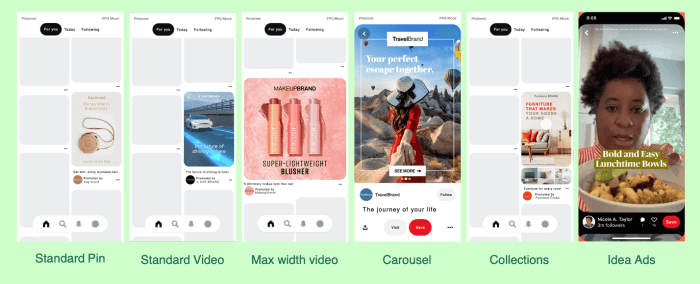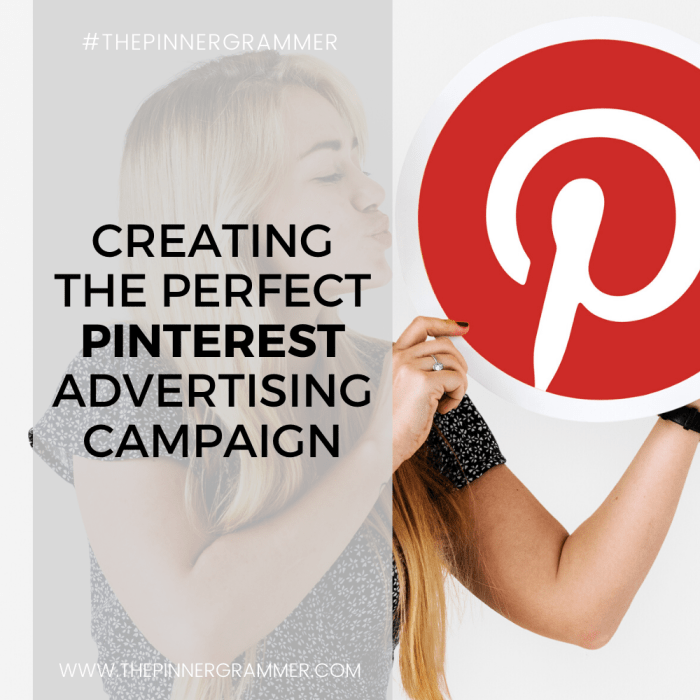Using Pinterest Ads dives into the world of visual marketing, offering businesses a unique platform to connect with their target audience in a visually appealing way. With a plethora of ad formats and creative opportunities, Pinterest Ads can take your marketing strategy to the next level.
Introduction to Pinterest Ads
Pinterest Ads are a unique advertising platform that allows businesses to reach their target audience in a visually engaging way. Unlike other advertising platforms, Pinterest focuses on inspiring users through images and videos, making it a great tool for businesses in the creative and lifestyle industries.
Benefits of Using Pinterest Ads
- Increased brand visibility: Pinterest Ads can help businesses showcase their products or services to a large audience of engaged users.
- Targeted reach: Businesses can reach their specific target audience based on interests, demographics, and behaviors.
- Drive website traffic: Pinterest Ads can drive traffic directly to a business’s website, increasing conversions and sales.
- Enhanced engagement: With visually appealing content, businesses can capture the attention of users and encourage interaction with their brand.
Ad Formats on Pinterest
- Promoted Pins: These are standard Pins that businesses pay to promote to a larger audience.
- Video Pins: Businesses can create engaging video content to showcase their products or services to users.
- Carousel Pins: These allow businesses to include multiple images in a single ad, providing a more interactive experience for users.
Setting Up Pinterest Ads Campaign

When setting up a Pinterest Ads campaign, follow these step-by-step process to ensure a successful ad campaign. First, log in to your Pinterest business account and click on the Ads tab. Then, click on the Create Ad button to start creating your campaign. Next, choose your campaign objective based on your advertising goals such as brand awareness, traffic, conversions, etc. After selecting your objective, you will need to set up your ad group by defining your target audience, budget, and scheduling.
Targeting Options on Pinterest, Using Pinterest Ads
- Interest targeting: Reach users based on their interests and behaviors on Pinterest.
- targeting: Target users based on specific s related to your product or service.
- Demographic targeting: Reach users based on factors like age, gender, location, etc.
- Retargeting: Target users who have previously engaged with your Pins or visited your website.
Setting Budget and Optimizing Ad Delivery
- Set a daily or lifetime budget for your campaign to control your spending.
- Optimize ad delivery by selecting the best performing Pins, targeting options, and scheduling for your ads.
- Monitor your campaign performance regularly and make adjustments to improve results.
Designing Effective Pinterest Ads: Using Pinterest Ads
Creating visually appealing pins is essential to capture users’ attention on Pinterest. The platform is highly visual, so your ads need to stand out and be eye-catching to drive engagement.
Importance of Creative Content
Creative content plays a crucial role in the success of Pinterest ads. It can impact ad engagement by making users stop scrolling and interact with your pin. The more creative and unique your content is, the more likely it is to resonate with your target audience.
- Use high-quality images that are bright, colorful, and visually appealing.
- Include text overlays to convey your message clearly and concisely.
- Experiment with different fonts, colors, and graphics to make your pins stand out.
- Consider using videos or GIFs to add movement and capture attention.
Successful Pinterest Ads Designs and Strategies
Successful Pinterest ads often follow certain design principles and strategies that have proven to be effective in driving results. Here are some examples of successful Pinterest ads designs and strategies:
- Carousel Pins: These allow users to swipe through multiple images or products in a single ad, increasing engagement and showcasing a variety of offerings.
- Story Pins: These immersive, full-screen ads tell a story and provide a more interactive experience for users.
- Rich Pins: These enhanced pins include extra information like product details, recipe ingredients, or article summaries, making them more informative and engaging.
- Promoted Pins: These ads blend in seamlessly with organic content on Pinterest, appearing in users’ feeds and search results to reach a wider audience.
Tracking and Analyzing Pinterest Ads Performance

When running Pinterest Ads, it’s essential to track and analyze their performance to ensure you are getting the best results. This involves monitoring key metrics like impressions, clicks, and conversions to make data-driven decisions and optimize your campaigns.
Tracking Key Metrics
Tracking key metrics such as impressions, clicks, and conversions is crucial for understanding how your Pinterest Ads are performing. Here’s how you can track these metrics:
- Impressions: The number of times your ad is displayed to users on Pinterest.
- Clicks: The number of times users click on your ad to visit your website or view more details.
- Conversions: The actions you want users to take after clicking on your ad, like making a purchase or signing up for a newsletter.
Tools for Analyzing Ad Performance
Pinterest provides a range of tools to help you analyze the performance of your ads. These tools can give you valuable insights into how your campaigns are performing and where you can make improvements. Some of the tools available on Pinterest include:
- Pinterest Analytics: Track the performance of your Pins and ads, including impressions, clicks, and engagement metrics.
- Conversion Tracking: Measure the actions users take after clicking on your ads, such as purchases or sign-ups.
- Ad Manager Reporting: Access detailed reports on your ad campaigns, including performance data and audience insights.
Optimizing Campaigns Based on Performance Data
Once you have tracked and analyzed the performance of your Pinterest Ads, it’s time to optimize your campaigns based on the data. Here are some best practices for optimizing your campaigns:
- Adjust Targeting: Refine your audience targeting based on the demographics and interests of users who are engaging with your ads.
- Update Creative: Test different ad creatives to see which ones resonate best with your target audience and drive the most conversions.
- Monitor Budget: Keep a close eye on your ad spend and adjust your budget allocation to focus on top-performing campaigns.
- Experiment with Formats: Try out different ad formats like Promoted Pins or Carousels to see which ones drive the best results for your objectives.
